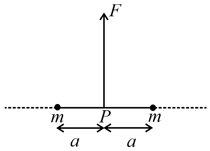Electric Charge
Electric Charge: Overview
This topic covers concepts, such as, Electric Charge, Types of Electric Charges, Interaction between Two Charges & Gold-Leaf Electroscope etc.
Important Questions on Electric Charge
A positively charged glass rod is brought close to a metallic rod isolated from ground. The charge on the side of the metallic rod away from the glass rod will be
All the statements given below are correct :
(A) Repulsion is sure test of electrification
(B) Two likely charged body may attract each other
(C) Electroscope is used to detect charge on object
(D) Electric force between point charges does not depends on nearer bodies
As shown in the figure, two particles, each of mass tied at the ends of a light string of length are kept on a frictionless horizontal surface. When the mid point of the string is pulled vertically upwards with a small but constant force the particles move towards each other on the surface. Magnitude of acceleration of each particle, when the separation between them becomes is

When a positively charged body is brought near the metal disc of a neutral electroscope, its leaves -
_____ (Lightning conductor/ Electroscope) is used to detect the presence of charge on an object.
Which device is used to detect the presence of charge on an object - lightning conductor or electroscope?
Gold leaf electroscope works on the principle of charging of a body by _____.
When an uncharged body is brought near a gold leaf electroscope, the leaves open up.
Gold leaf electroscope works on the principle of charging of a body by conduction.
Touching the disc of an electroscope will lead to its discharge.
For two point charges and , the product . What is the nature of the force between them?
Unit of electric charge is _____.
If electrons move out of a body to another body every second, then the time required to get a total charge of on the other body is
The number of electrons present in of charge is
An object is charged when it has a charge imbalance, which means the
Three charged particles are collinear and are in equilibrium, then
The total positive charge in a glass of water containing of water is approximately:
Two spheres A and B of exactly same mass are given equal positive and negative charges respectively. Their masses after charging
On charging by conduction, mass of a body may
If a body is positively charged, then it has
